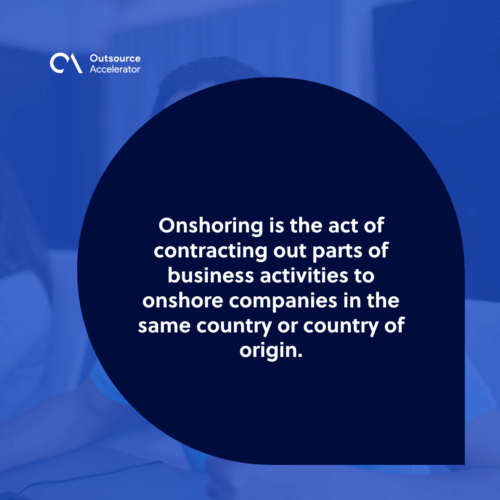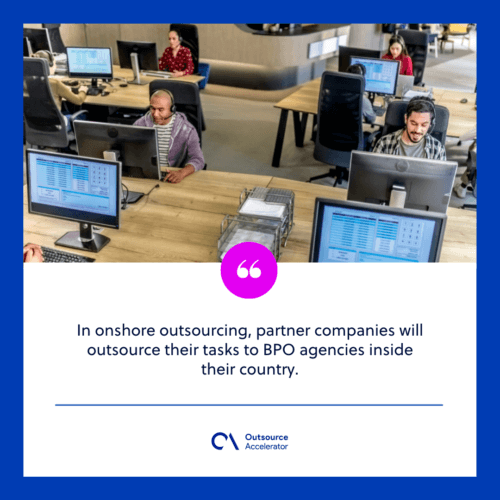Offshore vs onshore: Advantages and disadvantages

The offshore vs. onshore debacle has been going on for generations since both business models rose to popularity.
Offshore outsourcing has been a popular way for companies to cut costs without giving out a percentage of control to external third parties.
On the other hand, onshore outsourcing refers to rebuking all offshore activities and relocating back to their original country or location.
Both business models are valid ways of expanding the workforce and acquiring new talents for the company. But the question is, onshore vs offshore — which one is better?
What is offshoring?
To expound on what has been mentioned, offshoring is moving some or all business processes overseas. Some companies do it for tax exemption, and some do it to expand their business into another country and territory.
In simplest terms, offshoring is moving businesses to less-developed countries to cut costs effectively.
Offshoring services to developing countries like the Philippines enables businesses to utilize a global talent pool at lower costs.
Offshore companies offer varied offshore services. It can range from IT services, accounting, and HR functions to marketing, sales, creatives, and contact center services.
What is onshoring?
On the opposite spectrum, onshoring is contracting out parts of business activities to onshore companies in the same country or country of origin. By doing so, companies who engage in onshoring may stimulate the growth and development of local economies.

Offshore vs. Onshore outsourcing: Its advantages and disadvantages
| Offshore advantages and disadvantages | Onshore advantages and disadvantages | ||
| Advantages | Disadvantages | Advantages | Disadvantages |
| Globalization | Globalization (gone wrong) | Brand awareness | Lesser global reach |
| Special benefits | Cultural differences | Easier collaboration | Higher overhead costs |
Offshore advantage #1: Globalization
The practice of offshoring brings organizations somewhat “closer” to their overseas audience. Offshoring brings opportunities to locals of the country they choose.
Major conglomerates often have offices and branches worldwide to further their reach and connect with localities and regions in that area.
Names like Nestlé, Unilever, and Procter & Gamble have different “versions” of products to cater to locals.
Offshore disadvantage #1: Globalization (gone wrong)
Globalization is a double-edged sword. It drives out local businesses, as people would rather choose a name brand and a popular product over a locally made one.
Sometimes, companies that practice offshoring have disrupted local economies by driving local names out of business.
One infamous case of globalization gone wrong is the case of Nestlé disrupting biodiversity in African countries.
To combat this, the company devised a solution, Nestlé Cocoa Plan, in 2009. It aims to supply Nestlé with 100% sustainable cocoa by 2025.
According to Afrik21, “This includes stopping cocoa-related deforestation, increasing farmers’ incomes, ensuring high-quality cocoa, and addressing supply chain issues such as child labor, gender inequality, and poor social conditions.”
Onshore advantage #1: Brand awareness
Undoubtedly, onshore companies have a bigger audience reach when it comes to local and regional audiences. Chances are, onshore companies have become a part of the local brand names that are familiar to the general public.
It’s just another bonus that they’ve decided to become 100% part of the local industry again.
By opting for a domestic development team over offshore software development, businesses can effectively communicate their core values and establish a stronger brand presence in the local market.
Onshore disadvantage #1: Lesser global reach
Unless the company has a huge following outside of their resident country, chances are that they are not very well-known overseas.
Onshore companies, by default, are businesses that went global but pulled out offshoring after some time.
Offshore advantage #2: Special benefits
These special benefits are usually tax exemptions. In Southeast Asia, for example, local governments exempt offshore companies because they generate revenue from foreign countries, thus boosting the economy exponentially.
Furthermore, offshoring companies offer cost-effective services, and these are just two of offshoring’s vital advantages.
Offshore disadvantage #2: Cultural differences and language barrier
Besides time-zone differences, there can be a bit of culture shock when an offshore company first lands in a foreign country. Unless they have allocated a big budget to move and relocate employees overseas, most employ locals with the same expertise.
While having a diverse workforce is good, there might be some cultural differences that can hinder the development of the offshore team.
In terms of language barrier, offshoring to another country also means that the offshored dedicated team will not have the same native language.

Onshore advantage #2: Easier collaboration
Unsurprisingly, collaborating with an onsite and onshore team is easier. Everyone is within reach, and the team works simultaneously in the same place.
The morale of onsite teams is higher than that of offshore teams. Research shows that camaraderie is stronger when the teammates are physically present.
Onshore disadvantage #2: Higher overhead costs
Offshore teams are undoubtedly one of the most cost-effective teams out there—next in line would be remote workers and freelancers.
If there’s one disadvantage that onshore companies can tackle right away, it’s the higher overhead cost.
For instance, if a company goes onshore again, it must hire (or re-hire) local talents from its location. It will need to invest time, effort, and money in sourcing, interviewing, hiring, training, and onboarding.
Not to mention the cost of physically expanding the production floor. While both onshore and offshore companies offer the same services, offshore fees are much cheaper compared to onshore.
Is nearshoring still relevant?
Nearshoring has led some countries to offer subsidies for businesses in neighboring regions to meet those costs and retain growth at home.
With the rise of offshore and onshore outsourcing options, nearshoring strikes a balance by offering advantages such as geographic proximity, similar time zones, and cultural alignment.
In industries like onshore wind energy, nearshoring offers a cost-effective solution that reduces risks related to distances and communication barriers.
The practice of nearshoring is just like offshoring—business processes are still being relocated, but this time around, it’s somewhat nearer.
One prime example is the US and Canada, which are nearshoring to Mexico, Colombia, Peru, and other countries in South America.
Another would be UK-based companies nearshoring their business processes to Ukraine, Poland, and other Eastern European countries.
Offshoring jobs in 2024
Offshoring jobs in 2024 is made easier by business process outsourcing companies.
Business process outsourcing companies, mostly known as BPOs, are service providers. They assist businesses and corporations in offshoring and outsourcing their internal activities.
As we all know, BPO companies come by the dozen. The parent company chooses which one to partner with.
Why onshoring is more expensive than offshoring
This is not to say that onshoring is a generally bad idea. But compared to its counterparts such as outsourcing and offshoring, it’s just a tad bit more costly to move operations back onshore.
To combat this, some businesses adopt other ways to cut costs and to expand their operations without it getting too costly.
Internal hiring
As most business owners know, internal hiring is a tedious yet important part of successfully running a company.
Hiring involves human resources activities like sourcing candidates, interviewing, training, and onboarding. These activities can quickly consume time and effort, especially if the employee turns out to be a flunk for the position.
That being said, hiring the right candidate can pull the revenue up in the long run.
Training and onboarding
Training and onboarding were mentioned above, and these two can be costly if a company ever decides to onshore its processes once more.
For instance, new hires must be trained and onboarded before being sent to the production floor. As opposed to their more experienced counterparts, new hires aren’t pulling as much revenue into the company.
Overhead costs
This bears repeating: overhead costs are expensive—even for major companies.
Overhead costs include rent, utilities, and the cost of physical workstations such as desktops, laptops, desks, chairs, and more. These can pile up faster than management can imagine. Not to mention that most office supplies should be upgraded and/or maintained regularly.
Offshore vs onshore: The difference between onshore and offshore outsourcing
Onshore outsourcing and offshore outsourcing may sound similar to untrained ears, but there’s one big difference between them.
To start the debate about offshore vs. onshore, let’s define outsourcing first. Outsourcing is the process of outsourcing some tasks and responsibilities to an external service provider.
In outsourcing, clients (partner companies) don’t get to wholly control the process of which jobs are done.
In onshore outsourcing, partner companies will outsource their tasks to BPO agencies inside their country.
On the other hand, offshore outsourcing means businesses outsource their jobs to service providers outside the country.

Offshore vs. Onshore: Effectively managing teams
It’s not an easy task to manage any teams, much less if they are a distributed workforce. But most team managers don’t fret about it—instead, they channel that energy into making a productive environment.
Communication
Communication is key to a productive and positive work environment in any team. As the saying goes, communication is a two-way street.
Whether engaged in onshore customer support services or offshore operations, team members should feel that they can voice any questions and concerns to their team managers and other teammates.
The same goes for team managers; they shouldn’t feel burdened by unruly teammates who can’t take constructive criticism, especially regarding work.
Staff recognition
Positive feedback and staff recognition are two of the most important elements of managing a team.
Staff recognition spotlights the best employees to make them feel seen and validated in the workplace. This motivates them—and others—to be more productive and efficient when working on projects.
Transparency
Transparency in the workplace goes both ways, like communication.
Team managers should never withhold information from their members, especially if it’s directly related to work or a teammate, and vice versa. Of course, discretion is key.
If you’re looking for an outsourcing company with an admirable track record of transparency, you can consider Sourcefit.
Which is better: onshore or offshore?
That said, the age-old question remains: Which is better, onshore or offshore? Is answering the offshore vs. onshore question worth it? The answer can be found within the company, to be exact.
Business leaders and management can tell which they need more of. If onshoring is better for them, why would they try to offshore? The same goes for offshore ventures.
Employees should also have a say in the decision, as this drastic decision can affect their work.
Remember, good leaders never leave anyone in the dark.







 Independent
Independent




